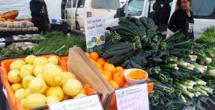2007 SA Premiers Food Awards
Winner: Environmental Sustainability
Food Forest most sustainable food production system
 |
 |

The Food Forest has again been judged South Australias most environmentally sustainable business in the food sector. What is it about this small, certified-organic property that has bowled-over the Premiers judging panels in the state food awards of both 2004 and 2007 as well as being named Australia's top organic producer by the Organic Federation of Australia year 2003?
The judges say it is because The Food Forests business practices and decisions are at all times guided by a sustainability ethic and integrated environmental practice. The place lives, eats, breathes and teaches sustainability, based on the principles of permaculture, a modern Australian design system that facilitates the sophisticated use of performance measurement, benchmarking and assessment of trends that will ensure environmental sustainability for the long term.
The judges also noted the Food Forests economic viability and the social and resource management contributions applied by the business throughout and beyond its boundaries through rehabilitation of adjacent public land, re-establishment of native fauna and collaboration with others through mentoring and a variety of programmed educational events, marketing and supply chain connections.
 Annemarie and Graham Brookman established The Food Forest from a bare paddock 24 years ago to promote a model for sustainable land use in semi arid agricultural areas and chose to grow crops that are well adapted to the environment near Gawler where the 15 hectare property is located; with 150 food species on trial, it is an extraordinary research farm producing pistachios, sweet carob beans, cider, wine, olive and jojoba oils, free-range geese, fruit and vegetables.
Annemarie and Graham Brookman established The Food Forest from a bare paddock 24 years ago to promote a model for sustainable land use in semi arid agricultural areas and chose to grow crops that are well adapted to the environment near Gawler where the 15 hectare property is located; with 150 food species on trial, it is an extraordinary research farm producing pistachios, sweet carob beans, cider, wine, olive and jojoba oils, free-range geese, fruit and vegetables.
The business became certified organic with the National Association for Sustainable Agriculture Australia (NASAA) in 1995 and Graham said that the records and testing required for ongoing certification make the monitoring of the environmental and economic indicators for the various enterprises surprisingly easy. We can determine the amount of irrigation water consumed to produce a kilo of pistachios, the income per kilolitre of water or the input energy compared with product energy for a range of enterprises said Graham.
Permaculture design demonstrates the concept of consciously harmonising a number of forms of production simultaneously on a particular piece of land, such as a nut orchard with barley growing between the trees as well as geese, bees and Brush Tailed Bettongs foraging; this optimisation of production provides multiple yields, biodiversity and environmental stability as well as big energy savings.
In order to avoid nutrients and organic carbon leaving the farm the Food Forest has developed value-adding systems which involve environmentally responsible equipment including a cold-room built with straw-bales, a photovoltaic system for generation of solar electric power and a high efficiency dehydrator built locally. All waste water from the home and food processing facility is recycled using reedbeds. Nutrients that leave the property in food that is sold are replaced by bringing in compost made from urban green waste and other sources.
Annemarie and Graham actively teach others how to make their properties, businesses, homes and gardens more sustainable at their learning centre which offers public weekend courses in almost everything to do with sustainable living, from organic vegetable growing to sustainable house design and involves experts as guest tutors. It also hosts visits by schools, university students and individual groups and has an educational website at www.foodforest.com.au
Graham acknowledged the contribution of Peter Wadewitz (pictured above on left with Graham) and his company Peats Soils in sponsoring the award that focuses attention on sustainability in the food industry which, through its massive use of water, energy, minerals and fuel, must remain a candidate for improvement.
Further information about the Premiers Food Awards and the SA State Food Plan is available on the Food South Australia website.
